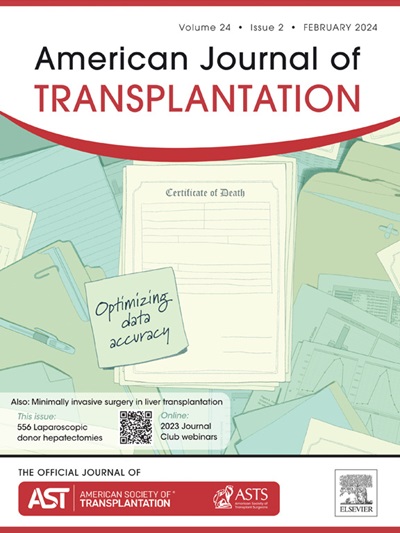非等位肾脏分配的当代流行与实践模式。
IF 8.9
2区 医学
Q1 SURGERY
引用次数: 0
摘要
自 2021 年以来,OPTN 报告的顺序外(OOS)肾脏分配增加了近 10 倍,引起了人们的关注,并阻碍了连续分配政策的发展。我们利用 OPTN 的数据报告了当代(2022-2023 年)OOS 分配的实践模式。我们通过多变量逻辑回归研究了顺序捐献者与OOS捐献者的关系,并通过条件逻辑回归研究了跳过捐献者与接受OOS捐献者的关系。近20%的肾脏配售为OOS,各OPO的OOS率从0%到43%不等;OOS率最高的5个OPO占所有OOS的29%。在 OOS 肾脏中,33% 的肾脏在标准分配序列中被拒绝超过 100 次,51% 的肾脏在 OOS 分配开始前被超过 10 个中心拒绝;4.5% 的肾脏在标准分配序列中未被任何中心拒绝。几乎所有的 OOS 供肾都是公开供肾。OOS肾更可能来自女性、黑人、老年人、DCD、高血压、糖尿病和肌酐升高的供体。接受 OOS 肾脏的候选者中,女性、亚裔和老年人的比例高于跳过的候选者。数量较多的中心以及白人较多、西班牙裔较少和受教育程度较高的候选者中心移植的OOS肾脏数量多得不成比例。这些研究结果表明,目前随意使用OOS的情况非常多变,可能会加剧差异,但目前收集的数据还无法确定OOS对器官利用率的影响。本文章由计算机程序翻译,如有差异,请以英文原文为准。

Contemporary prevalence and practice patterns of out-of-sequence kidney allocation
Since 2021, the Organ Procurement and Transplantation Network has reported a nearly 10-fold rise in out-of-sequence (OOS) kidney allocation, generating concern and halting development of continuous distribution policies. We report contemporary (2022-2023) practice patterns in OOS allocation using Organ Procurement and Transplantation Network data. We examined in sequence vs OOS donors with multivariable logistic regression and skipped vs OOS-accepting recipients with conditional logistic regression. Nearly 20% of kidney placements were OOS, varying from 0% to 43% acsoss organ procurement organizations; the 5 highest OOS-organ procurement organizations accounted for 29% of all OOS. Of OOS kidneys, 33% were declined ≥100 times in the standard allocation sequence and 51% were declined by ≥10 centers before OOS allocation began; 4.5% were made without any in-sequence declines. Nearly, all OOS offers were open offers. OOS kidneys were more likely to be from female, Black, older, donation after cardiac death, hypertensive, diabetic, and elevated creatinine donors. Candidates receiving OOS kidneys were more likely female, Asian, and older than skipped candidates. Higher-volume centers and centers with more White, fewer Hispanic, and more educated waiting list patients underwent transplantation disproportionately with more OOS kidneys. These findings suggest that the current, highly variable, discretionary use of OOS might exacerbate disparities, yet the impact of OOS on organ utilization cannot be determined with data now collected.
求助全文
通过发布文献求助,成功后即可免费获取论文全文。
去求助
来源期刊
CiteScore
18.70
自引率
4.50%
发文量
346
审稿时长
26 days
期刊介绍:
The American Journal of Transplantation is a leading journal in the field of transplantation. It serves as a forum for debate and reassessment, an agent of change, and a major platform for promoting understanding, improving results, and advancing science. Published monthly, it provides an essential resource for researchers and clinicians worldwide.
The journal publishes original articles, case reports, invited reviews, letters to the editor, critical reviews, news features, consensus documents, and guidelines over 12 issues a year. It covers all major subject areas in transplantation, including thoracic (heart, lung), abdominal (kidney, liver, pancreas, islets), tissue and stem cell transplantation, organ and tissue donation and preservation, tissue injury, repair, inflammation, and aging, histocompatibility, drugs and pharmacology, graft survival, and prevention of graft dysfunction and failure. It also explores ethical and social issues in the field.

 求助内容:
求助内容: 应助结果提醒方式:
应助结果提醒方式:


